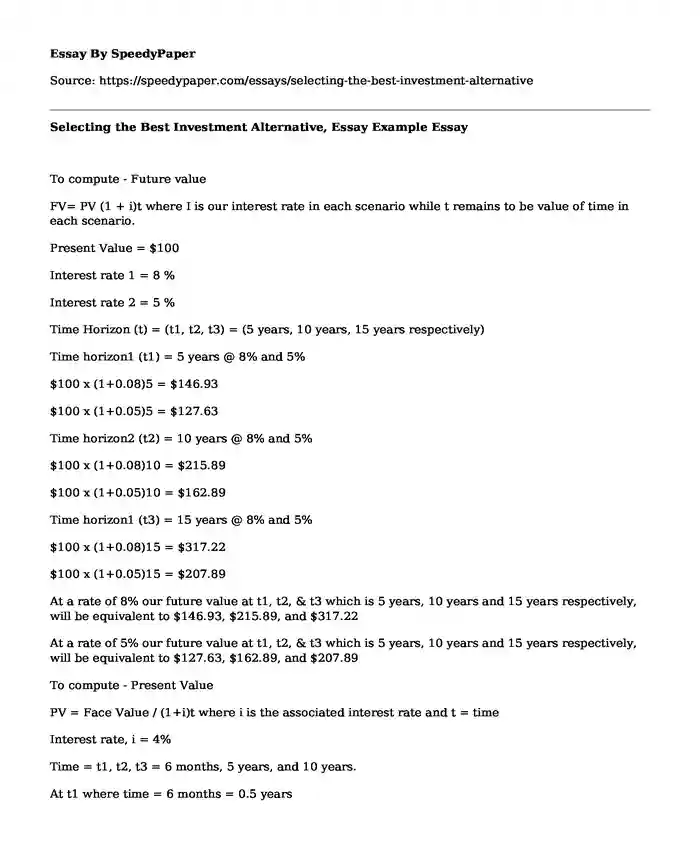To compute - Future value
FV= PV (1 + i)t where I is our interest rate in each scenario while t remains to be value of time in each scenario.
Present Value = $100
Interest rate 1 = 8 %
Interest rate 2 = 5 %
Time Horizon (t) = (t1, t2, t3) = (5 years, 10 years, 15 years respectively)
Time horizon1 (t1) = 5 years @ 8% and 5%
$100 x (1+0.08)5 = $146.93
$100 x (1+0.05)5 = $127.63
Time horizon2 (t2) = 10 years @ 8% and 5%
$100 x (1+0.08)10 = $215.89
$100 x (1+0.05)10 = $162.89
Time horizon1 (t3) = 15 years @ 8% and 5%
$100 x (1+0.08)15 = $317.22
$100 x (1+0.05)15 = $207.89
At a rate of 8% our future value at t1, t2, & t3 which is 5 years, 10 years and 15 years respectively, will be equivalent to $146.93, $215.89, and $317.22
At a rate of 5% our future value at t1, t2, & t3 which is 5 years, 10 years and 15 years respectively, will be equivalent to $127.63, $162.89, and $207.89
To compute - Present Value
PV = Face Value / (1+i)t where i is the associated interest rate and t = time
Interest rate, i = 4%
Time = t1, t2, t3 = 6 months, 5 years, and 10 years.
At t1 where time = 6 months = 0.5 years
PV1 = $100 / (1+0.04)0.5
PV1 = $100 / 1.0198 = $98.06
Hence, PV1 will be equivalent to $98.06
At t2 where time = 5 years
PV2 = $100 / (1+0.04)5
PV2 = $100 / 1.2167 = $82.19
Hence, PV2 will be equivalent to $82.19
At t3 where time = 10 years
PV3 = $100 / (1+0.04)10
PV3 = $100 / 1.4802 = $67.56
Hence, PV3 will be equivalent to $67.56
Ultimately, the present value of our $100 investment made at 6months, 5years and 10years respectively will be $98.06, $82.19 and $67.56 respectively.
3) To calculate the value of our bond
To compute the value of a 5 year, 5% coupon bond with a face value of $1,000 at an interest rate of 3%.
Value of Bond = present value of annuities + present value of face value of the bond
Value = PV annuity + PV face value
To calculate PV Annuity
Coupon rate = 5% = 0.05
Annual interest payments will be=face value x coupon rate = $1000 x 0.05 = $50
Hence, the present value of interest payments (Annuities) will be = $50 x 1 - 1(1 + r)-t / r where r represents the interest rate, and t the associated time.
PV annuity = 50 x 1 - 1(1 + 0.03)-5 / 0.03 = 50 x 1/1.1593 x 100/3
PV annuity = 50 x (1- 0.8626) / 0.03 = 50 x 4.5797 = $228.99
To calculate PV face value = F (1 + interest rate)-n
PV face value = $1000 (1 + 0.03)-5
PV face value =$1000 x 1/1.159274
PV face value =$862.61
Hence the value of our bond will be $228.99 + $862.61 = $1,091.60
What happens when the interest goes to 4% and what happens when the interest goes to 2%?
When the market rate shifts to 4%, it simply means that the bonds at hand will be giving us a lower return than what a bond purchased at the new market rate would be fetching. While our previously bought $1000 worth of bonds will continue to receive annuities at the rate of 3%, $1,000 worth of bonds bought after the shift in the market will be receiving coupons at the rate of 4% constantly until maturity, hence inequality in returns with the 3% coupon bond being less profitable. On the other hand, if the interest rate drops to 2%, it simply means that the $1000 bonds initially in possession will have much a higher return than what is currently being offered in the market, making the previously possessed bonds much more valuable and worth holding on to unlike in the first instance.
4. Selecting the best Investment Alternative
From the two investment alternatives, based on numerical analysis of both investments, I would go for the one that pays 0.5 percent per month for five years. Using a mathematical expression to illustrate the same, assuming we have $100 to invest in either of the two options, in the first instance, the total return would be equivalent to $100 x (1+0.3)1 which is a total return of $130. On the other hand, if we opted to invest the $100 in the second option, our total return would be equivalent to = $100 x (1+0.005)12*5 = $100 x 1.3488 = $134.88
From both illustrations, this simply indicates that our investments are better off in the second option that pays 0.5% per month as it will pay an additional 4.88% return on any investment made as compared to the first option.
Cite this page
Selecting the Best Investment Alternative, Essay Example. (2022, Mar 18). Retrieved from https://speedypaper.net/essays/selecting-the-best-investment-alternative
Request Removal
If you are the original author of this essay and no longer wish to have it published on the SpeedyPaper website, please click below to request its removal:
- Free Essay with a Letter of Application Example
- Marketing Essay Sample - Pricing Strategy
- What Respect Means to Me - The Answer in This Free Essay
- Free Essay on Sociology of Religion Questions
- Free Essay for Students: Health and Healthcare Disparities
- Essay Example Dedicated to Learning Organization
- Free Paper Sample on Forensic Evidence
Popular categories





